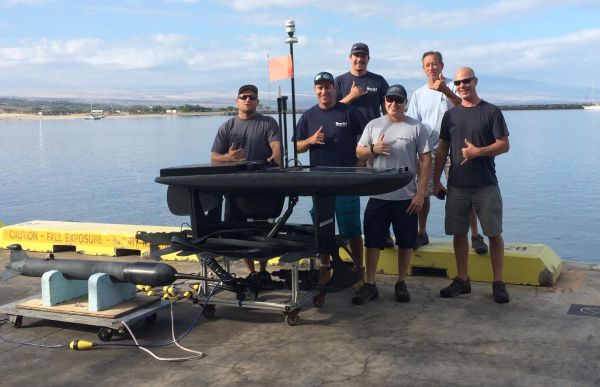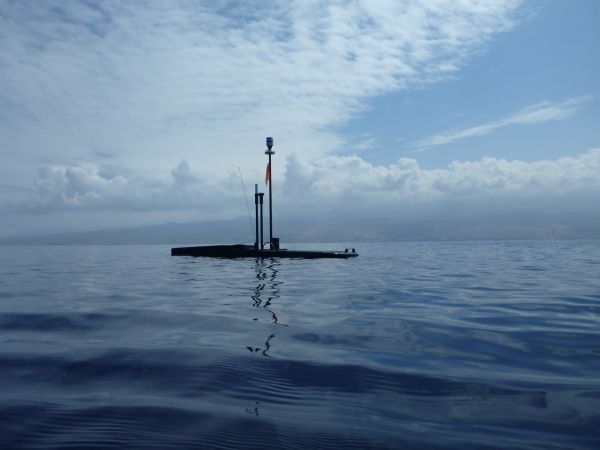Fluorescence data (C3) collected by the AUV Honey Badger (Wave Glider) in the North Pacific gyre in 2015 (MAGI project)
Project
| Contributors | Affiliation | Role |
|---|---|---|
| Villareal, Tracy A. | University of Texas at Austin (UT Austin) | Principal Investigator, Contact |
| Wilson, Cara | National Oceanic and Atmospheric Administration - Southwest Fisheries Science Center (NOAA SWFSC ERD) | Co-Principal Investigator |
| York, Amber D. | Woods Hole Oceanographic Institution (WHOI BCO-DMO) | BCO-DMO Data Manager |
This dataset includes chlorophyll, phycoerythrin, and CDOM data from the AUV Honey Badger (Wave Glider model V2) during a 2015 deployment in the North Pacific Ocean.
For more information on project MAGI and a description of Honey Badger, see: http://oceanview.pfeg.noaa.gov/MAGI/
Additional support was provided by the PacX Challenge from Liquid Robotics, Inc.
Data were collected at the surface by the the AUV Honey Badger (a Wave Glider(R) model SV2 from Liquid Robotics). This deployment in the North Pacific Ocean is part of Project MAGI. For more details about the Honey Badger and project MAGI please see project page:
http://oceanview.pfeg.noaa.gov/MAGI/
Chlorophyll, phycoerythrin, and CDOM data were aquired from two float-mounted Turner Designs' C3™ Submersible Fluorometers. Biofouling is a big issue for any long deployment vehicle, and having two sensors provided the redundancy needed for data quality assurance. No calibration was deemed useful due to the duration of the mission and nature of questions asked.
No calibration was deemed useful due to the duration of the mission and nature of questions asked. Sensors returned only RFU.
BCO-DMO Data Manager Processing Notes:
* added a conventional header with dataset name, PI name, version date
* modified parameter names to conform with BCO-DMO naming conventions
* blank values replaced with no data value 'nd'
* values of "NaN" and "nan" changed to "nd"
* latitude and longitude were rounded to 5 decimal places from 12
* data version "2017-07-07" replace the previous version "2016-08-09." This version includes data from other control boards besides control board 3.
| File |
|---|
c3.csv (Comma Separated Values (.csv), 2.28 MB) MD5:f1fe91e68ac3b70e22b2956984d9da88 Primary data file for dataset ID 653653 |
| Parameter | Description | Units |
| ISO_DateTime_UTC | Time (UTC) in format YYYY-mm-ddTHH:MM:SS[.xx]Z | unitless |
| lat | Latitude | decimal degrees |
| lon | Longitude; west is negative | decimal degrees |
| chl | Chlorophyll fluorescence | relative fluorescence units |
| CDOM | Colored dissolved organic matter | relative fluorescence units |
| phycoerythrin | Phycoerythrin; red protein pigments | relative fluorescence units |
| temp | Temerature | degrees Celcius |
| Dataset-specific Instrument Name | fluorometer |
| Generic Instrument Name | Fluorometer |
| Dataset-specific Description | Turner float-mounted C3 fluorometers equipped for chl, phycoerythrin and CDOM.
For more details see:
http://www.turnerdesigns.com/products/submersible-fluorometer/c3-submers... |
| Generic Instrument Description | A fluorometer or fluorimeter is a device used to measure parameters of fluorescence: its intensity and wavelength distribution of emission spectrum after excitation by a certain spectrum of light. The instrument is designed to measure the amount of stimulated electromagnetic radiation produced by pulses of electromagnetic radiation emitted into a water sample or in situ. |
HoneyBadger2015
| Website | |
| Platform | AUV Honey Badger |
| Start Date | 2015-10-31 |
| End Date | 2015-11-04 |
| Description | The AUV Honey Badger is a Wave Glider(R) (model SV2) from Liquid Robotics. It was deployed from the Island of Hawai'i in May of 2015 as part of Mesoscale Features Aggregate Interactions (MAGI) project. The trackline is in the North Pacific Ocean and passes the ocean time-series station ALOHA.
For more information on project MAGI and a description of Honey Badger, see: http://oceanview.pfeg.noaa.gov/MAGI/ |
Long Duration AUVs as tools to explore Mesoscale feature aggregate interactions (MAGI) (MAGI)
NSF award abstract:
Remote areas of the ocean are difficult to sample for short-lived or episodic features. This project will use a new sampling platform, the Wave Glider, and provide a continuous presence in the central North Pacific gyre. The six month duration of the mission will allow repeated sampling as well as spatial coverage previously unavailable. This mission will incorporate phytoplankton specific sensors as well as a set of optical sensors that will provide information on distribution, physiology and aggregation of a unique diatom-nitrogen fixing cyanobacterium symbiosis. When completed, this program will have generated the first data sets that follow these diatom blooms over extended periods in the region. Access to this instrumentation was facilitated by the PacX challenge, an international competition to produce high quality research from long-duration autonomous vehicles in the North and South Pacific Ocean. As a result of winning that competition, the principal investigator has been awarded the use of 6 months of the Honey Badger Wave Glider time in 2014. The Wave Glider is a wave-powered surface vessel capable of extended duration missions. In order to maximize this the principal investigator will outfit the glider with advanced sensors to quantify zones of intense diatom activity and aggregation along mesoscale features in the Pacific (Project MAGI: Mesoscale feature-AGregate Interactions).
Note: This project is funded by an NSF RAPID award.
[ table of contents | back to top ]

